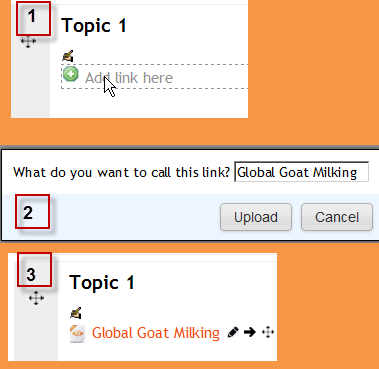URL resource settings: Difference between revisions
Mary Cooch (talk | contribs) (adding experimental drag/drop URL) |
Helen Foster (talk | contribs) m (moved URL module settings to URL resource settings: easier to understand title) |
(No difference)
| |
Revision as of 09:58, 1 August 2012
Adding a new URL to your course
There are two ways of adding a link to a website of online file to your course page.
The quick method
- This requires the administrator to check the box "Drag and drop upload of text/links" in Settings>Site administration>Development>Experimental
- With the editing turned on, drag a link into a section of your course (1 below) You will be prompted to give it a name (2 below) Name it and then click "Upload" (3 below)
The longer method
- ChooseURL from the "Add an activity or resource" link (or, if not present, the "Add a resource" drop down menu) in your course.
- The "Adding a new URL" screen will ask for a link name and a description (which may be required or optional according to the admin settings)
- In the "Content" box you type or paste a copied external weblink. The "Choose a link" button takes them to the file picker where they can choose URLs from online areas such as youtube, Box.net, Picasa, Merlot etc, depending on what admin has allowed.
Course administration settings
Display options
- Automatic - Make the best guess at what should happen (probably what is wanted 99% of the time).
- Embed - Show the Moodle page with heading, blocks and footer. Show the title/description of the item and display the file directly in the page as well
- Open - No Moodle heading, blocks, footer or description - just show the file in the web browser (e.g. shows image, PDF, flash animation, taking up the whole browser window)
- In pop-up - Same as 'Open', but opens a new browser window to show this file (without the Moodle heading, blocks, etc) - this browser window also does not have all the menus and address bar in it.
- There are additional options if you enable them via Site administration > Plugins > Activity modules > URL:
Advanced Settings
Parameters
The parameters section allows you to pass internal information as part of the URL.
This is useful if the URL is actually an interactive web page that takes parameters, and you want to pass something like the name of the current user, for example.
Other settings
There are the usual Common module settings and the Restrict access settings Conditional activities. There is also an option to display the URL description on the course page below the link to the URL.
URL module capabilities
Site administration settings
The URL module has additional settings which may be changed by an administrator in Settings > Site administration > Plugins > Activity modules > URL.
Frame height
Here you can specify the height of the top frame (containing the navigation) if you choose the "in frame" display option. Note:If your theme has a large header then the height should be increased to prevent horizontal and vertical scrollbars.
Require activity description
This setting allows you to turn off the requirement for users to type something into the description box.
Password
Here you can add a password that will connect your users to a secure site. See this forum post for more details.
Include role names in parameters
Available display options
This setting allows you to add different ways the resource may be displayed on the course page. There are a number of defaults but you can add or change them here. Other display options are;
- In frame - show the Moodle heading and the file description, with the file displayed in a resizable area below
- New window - very much like 'in pop-up', but the new window is a full browser window, with menus and address bar, etc.
Default values for activity settings
Here you can set the defaults for this resource. You can also choose which setting(s) to class as "Advanced". These settings will only then appear if the user clicks "Show advanced" in the settings.


